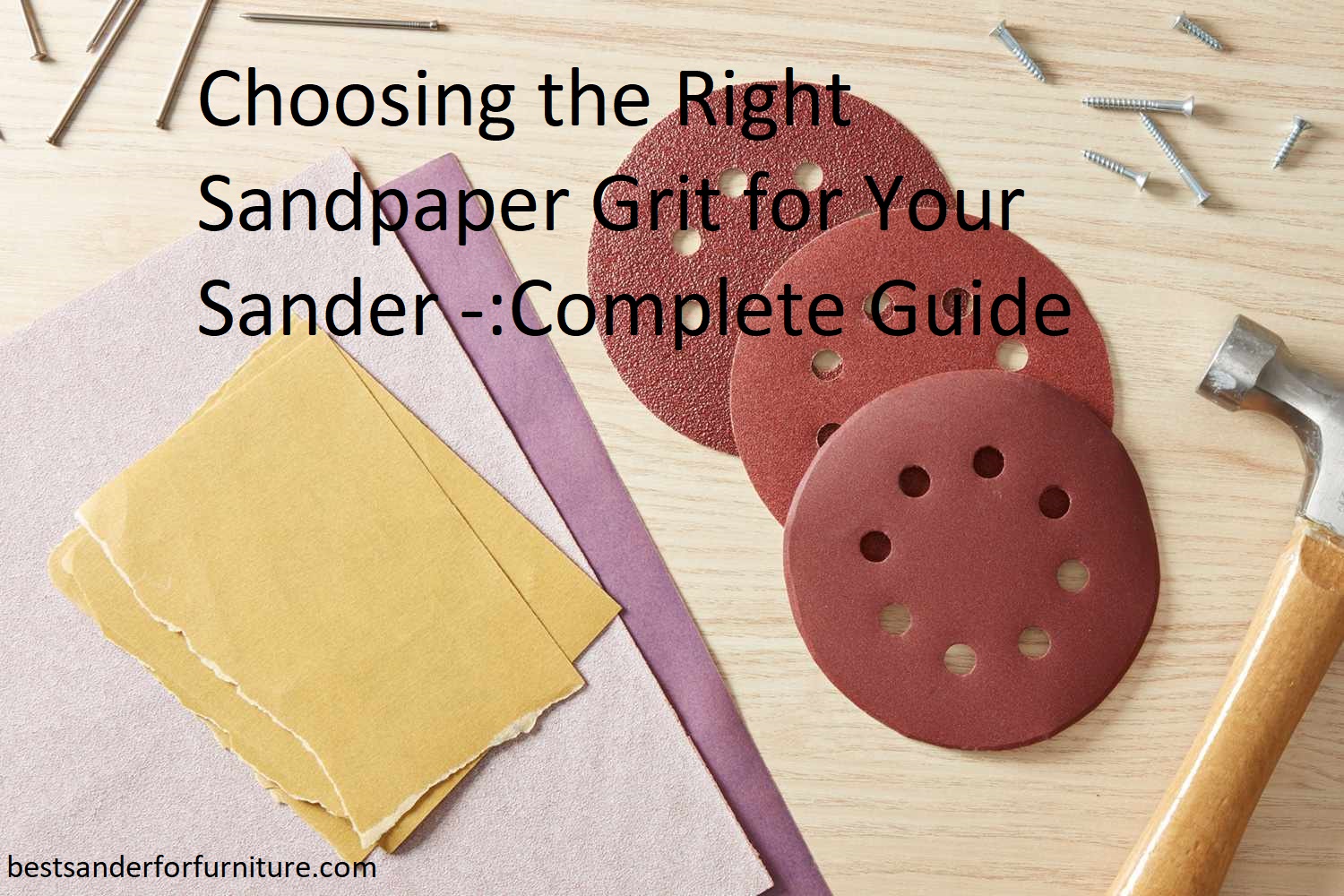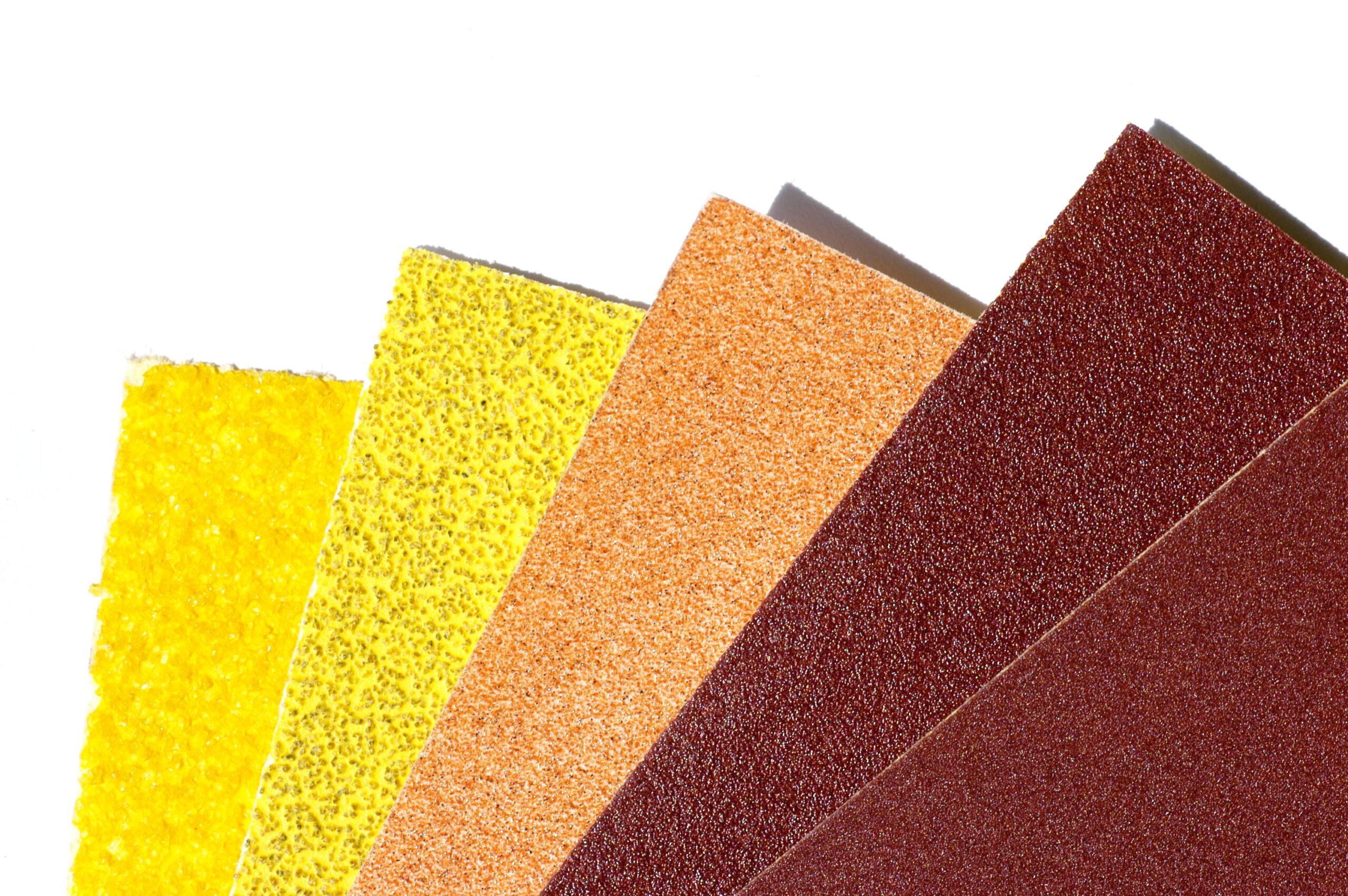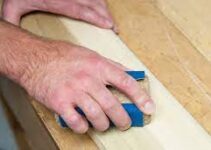Are you looking for the perfect sandpaper grit for your next DIY project? Let us help you choose the best option for your sander by walking you through this comprehensive guide. You’ll soon be turning those rough surfaces into silky smooth works of art!
Sandpaper is an essential tool for any DIYer’s toolbox. It is used for manjobs ranging from sanding down paint, drywall and wood for softer finishes, to machine sanding and polishing surfaces. With all the different types of materials you may be sanding, it’s important to understand the different grits that are available, so you can properly choose the right one for the job. This guide will go over a few basics to help you pick out the proper grit of sandpaper for your sander.
The term “grit” refers to the size of abrasive particles in a sandpaper sheet. Grits are represented by a numerical system running from coarse (24 or 36) to medium (50 or 60), to fine (80). Coarse grits remove material quickly but leave heavier scratches and marks; fine grits remove material more slowly and result in smoother surfaces. The most common type of sandpaper used for DIYers is between 40-200 grit.
When choosing a particular type of sandpaper with an appropriate amount of grain size, it’s important to consider what kind of surface you’re working on as well as what type of sander you’re using: orbital sander, angle grinder, belt sander etc. If you’re dealing with rough surfaces that need high removal rate then choose a coarse grit; if working with smooth surfaces require fewer markings then select finer grains such as 150 or 200-grit paper. A good rule is to start with a medium-coarse (60-80) grit before moving on to finer grades around 150-grit paper followed by 220-grit or higher grades like 320 if necessary. Depending on the task at hand, it’s best not to exceed 320 should further scratch marks appear in order not cause too much damage yet still get desired results!
Understanding Sandpaper Grit
While sandpaper comes in many different grades, some of the most commonly used grades are measured in terms of their grit size. Grit is essentially the measure of how coarse or fine a given sandpaper is and the grit size is usually indicated by a number on the sandpaper itself. The larger the number, the finer, or smoother, the material; conversely, sandpapers with lower numbers represent coarser materials.
Understanding what these different grit sizes indicate is essential to getting really excellent results when tackling a job. For example, it might make sense to start with a coarser grade and then gradually switch to something finer if you are looking to achieve a truly smooth finish. Coarse grits require less work overall since they can quickly remove stock from surfaces while finer grits are great for creating an ultra-smooth finish on pieces of wood or metal.
The table below provides an overview of what these different sandpaper grit sizes represent:
Number Grit Size Grit Usage
80–100 Extra Coarse Stock Removal/Heavy Sanding
120–150 Coarse Fast Stock Removal/Rough Shaping
180–220 Medium Coarse Smoothing Rough Surfaces/Mild Sanding
220–280 Medium Fine Smoothing Wood & Metal/Fine Sanding
320–400+ Fine Pre-Finish Smoothing/Polishing Wood & Metal
Definition of sandpaper grit
Sandpaper grit is a measure of the abrasive material on the paper. Sandpaper with a lower number indicates larger abrasive particles that are more like gravel than fine sand. The higher the number of the grit, the finer and softer the sandpaper becomes. When choosing sandpaper grit for finishing, you should use different sizes to achieve a smooth finish.
Grits are usually written as a range or single value, such as 150-200 grit, where 150 is the coarsest and 200 is the finest grit size. Sanding with finer grits will remove less material than coarser ones, so it’s important to start with coarse enough sandpaper for your job to ensure adequate stock removal. A basic rule of thumb is that you should always begin sanding with at least twice as coarse of a grit as what you plan on using for your final finish.
Explanation of the numbering system
Understanding the numbering system can help you figure out which sandpaper grit is best for any particular job. Sandpaper is labeled with a number that indicates its level of coarseness, ranging from high numbers (low grit) to lower numbers (high grit). The higher-number grits represent a finer abrasive and smoother sanding surface than lower-number grits.
The most common sandpapers range from 36–400 in their numerical scale, although many users have access to even coarser or finer grits than this. Generally, it’s recommended that you begin with either an 80-grit or 100-grit paper and work up to the finishing stage of the project, which should consist of at least 320 or 400-grit. Here is a complete list of standard numbering systems:
36–60 Grit – Extra Coarse Grit – For removal of material quickly and aggressively
80–120 Grit – Coarse Grit – For sanding bare wood and shaping irregular surfaces
150–180 Grit – Medium Grit -For prepping finished surfaces for staining
220 –240 Grit – Fine Grit- Sanding between coats of paint or varnish
320 – 400 Grit – Very Fine/UltraFineGirt – Final step for polishing projects
Relationship between grit and coarseness
When selecting the right sandpaper grit for your sander, it is important to understand the relationship between grit and coarseness. The grit number is an indication of the size of abrasive particles on the sandpaper–the higher the number, the finer the grit. Generally speaking, a higher grit yields a smoother surface on your project while a lower grit provides more aggressive cutting power.
With this in mind, you’ll want to think about what type of work you’re doing and pick your sandpaper accordingly. For example, if you are doing detailed work or working with fragile surfaces, it may be best to opt for a higher-grit paper so as not to damage them further. On the other hand, if you are wanting to do some heavy-duty sanding or paint removal, then a lower-grit paper will best meet your needs in providing more aggressive abrasion.
Knowing how different materials respond differently to different abrasives will help you understand what type of paper is best for each particular job that you do.

Schleifpapier, verschiedene Sorten
Choosing the Right Grit for Your Sander
Grit numbers are the measure of how fine the sandpaper is, with higher numbers indicating a finer grade of sandpaper. Each grit number corresponds to a generally-understood level of roughness, though that can depend upon the type of abrasive material used.
When it comes to picking the right grit for your sander, it’s important to remember that you should generally aim to use an abrasive with higher grits if you’re smoothing or finishing surfaces and lower-numbered grits if you’re shaping or removing material quickly. The type and size of your project should guide your decision as well; large surface areas may require lower number abrasives while smaller projects may require finer grades.
Understanding how each number scale correlates to specific applications can help decide which abrasive product will best fit your needs:
-Very coarse (24-36): Used on ferrous metals only, these abrasives remove rust and paint quickly but leave behind a rough finish. Ideal for removing excess material from wood cutting tools or machines.
-Coarse (40/60): Grits in this range are best for heavy stock removal like what you’d find during initial stages of wood sanding. Generally not suitable for detailed work or fine finishing results due to its coarse pattern marks left in the surface.
-Medium (80/120): Versatile grit range great choice when smoothing between coats of paint as well as light shaping and level grinding applications – won’t leave behind an overly rough surface finish. Ideal for general purpose machining setups such as rough polishing of metals or general carpentry tasks such as leveling door frames prior to installation.
-Fine (150/180): Very fine grade for light sanding jobs that call for minimal scratches in products like musical instrument components, highly delicate chemical equipment, especially where surface contamination is undesirable upon completion of job at hand – also ideal for light deburring operations on most any type material including plastics and ferrous alloys.
-Super fine (220/280): Extremely fine grade typically used in applications where ultra smooth finishes are desired such as automotive finish sanding processes before applying primer or color coatings; also used in many aerospace grade parts fabrication requiring exquisite level near “mirror” polish often seen among extremely expensive precision machined components made out of hardened steels alloys and other exotic materials trimmed down to perfection by leading industry professionals worldwide!
Low grits (Coarse)
Low grit sandpapers vary in range from 36–60 and they are the coarsest of all sandpaper varieties. When using low grit sandpaper on a power sander, it is important to lightly feather the stones or wood being worked and avoid pressing hard, as that increases heat build up which can damage items quickly.
The most common use for sanders with low grits is for aggressive stock removal such as removing:
- Paint
- Varnish
- Glue
- Sap and resin from outdoor logs
- Rust from metal surfaces, etc.
In construction projects, this type of sandpaper is used for quick stock removal when dealing with rough cuts, or in cases where removing large amounts of material is the goal. Low grits can provide a great finish if kept moving and pressure isn’t applied while in use. Low grits should be avoided when working with delicate woods, stones or metals that could be easily scratched due to the coarse nature of these papers.
Medium grits (Medium)
Choosing the right sandpaper grit for your sander is essential to achieving a smooth, professional finish. There are many types of sandpaper available with different grits from fine to coarse, but understanding the differences between them can help you decide which one to use. When selecting a medium grit sandpaper, look for those labeled 80-150 grit. This type of paper removes material quickly and produces a smooth surface in less time than a fine grit paper.
Medium grits are versatile and can be used on many different materials, such as wood, plastic and metal. They’re great for removing imperfections in the surface and smoothing out rough patches. However, they should not be used on surfaces that need to have a very polished look; use fine or extra-fine sandpaper instead. Medium-grit papers also work well for prepping materials before painting or finishing them with stains or varnish because they adhere easily to the underlying material due to its coarseness.
When it comes to proper use of your sander, always make sure you are using the correct type of paper for each project based on the desired results and material being worked with. Choose medium-grit papers when you want an efficient way to remove imperfections from many materials quickly without significantly smoothing out surfaces too much before finishing them off with finer papers like 400 – 800 grits later on in the project.
High grits (Fine)
High grits, also known as fine sandpaper, refer to any paper with a grit rating of between 400-1000 on the FEPA/P scale. This type of sandpaper is used for finishing and polishing various surfaces. Its ability to provide a smooth finish makes it suitable for tasks such as lightly buffing out dried paint, smoothing out the surfaces of natural stone, refinishing furniture pieces, working on wooden floors and more.
High grit sandpaper is often used to remove light scratches and paint chips, revealing smoothness underneath. It can be used in place of traditional steel wool and metal polishers that take significantly longer time and cause harm to surfaces when used improperly because high grit paper creates less dust residue overall. Additionally, higher-grit papers are key components in automotive polishing processes because they help create a superior finish that would not be achievable with a lower-grit paper due to their finer quality materials and smoother cutting capabilities.
Common Sandpaper Grit Uses
Once you determine the right sandpaper grit for your sanding project, there are a few general rules of thumb for deciding which grit to use when. These guidelines will help you achieve the desired finish.
- Rough Sanding – Use coarse-grit sandpaper (generally in the 24 to 36 range) for rough sanding and removing large amounts of material from your workpiece.
- Intermediate Sanding – Switch to intermediate-grit paper (typically in the 80 to 120 range). This will smooth down any visible ridges left by the coarse grit, as well as give a more refined surface. It’s also recommended for prepping surfaces before staining or painting.
- Finish Sanding – For finishes, use fine-grit papers (150-245 range). You can also use extra fine papers such as 400 and above if you want glossy surfaces after staining or painting.

Woodworking
When woodworking, choosing the right sandpaper grit is essential to achieving an attractive, professional finished product. Grits are categorized as either smooth, medium or coarse. The coarseness can be determined by the size of the abrasive particles it contains. Variety of different types of wood – such as softwood, hardwood, and exotic woods – vary in their ability to accept finish and should be addressed with the appropriate grit paper.
Smooth grit paper ranges from 240-1000 grit with many types in between those numbers. This type of sandpaper is most useful for fine-tuning lightly scratched surfaces or preparing a natural finish on softwoods like pine and spruce. Softwood exhibits open pores which show up on a flat surface when not filled; therefore, it needs to be addressed differently than hardwoods or exotic woods which lack these open pores and do not need to be filled-in first before staining or finishing with a natural product.
Medium grade sandpapers range from 60-200 grits with many types in between those numbers. This type of sandpaper works best on scraped surfaces where there is already an existing finish applied but not uniform over the whole surface area. It’s a good idea to use this grade paper when you begin your compounding process afterwards following light scratch removal because it offers more aggressive cutting power than finer grades used directly on wood surfaces before staining or finishing them naturally.
Metalworking
If you’re working with metal surfaces, then the type of sandpaper you choose is important for achieving a smooth and safe final finish. As a general guide, when sanding metal it’s best to start off with a medium grade paper such as 50 or 80 grit and then progress through increasingly finer grades up to 220 before finishing with 400-600 grit paper. Smaller projects may be able to use lighter grades for faster stock removal if required.
To achieve an optimal finish with your sander it’s important that you use the correct grit for each stage of the process. Coarser grade papers (such as 50-80) should always be used first before the finer grades are ever touched. This is because coarse grains have larger spaces between particles that are better at breaking down material quickly or removing previous coatings while still being kind to lower hardness materials like metals without compromising their integrity/microstructure. By beginning with a coarse grit you also ensure any marks left behind by previous stages can be removed easily without a lot of extra work.
Once all major blemishes have been removed, switch to a 180 or 220-grit paper to refine the surface and make sure it’s completely smooth by using light, steady pressure throughout each pass or stroke on your sander while aiming away from any sharp edges on your workpiece. Taking short controlled passes will also help prevent further damage from occurring if something were to slip out of place during sanding! Finally, switch over to finer 400-600 grit papers for one last polishing phase before adding any protective coating.
Automotive
Automotive projects require a different kind of sandpaper from other common uses. Usually, these surfaces don’t require a really high grit, as the painting process will finish the job and make it shine. However, the wrong grit size can ruin the surface you are working on and create problems later on down the line.
When sanding automotive surfaces, you should use 150 – 220 grit papers and if possible, always go with grit sizes that are only 5 – 10 points apart to ensure that you create a smoother transition in between them. In terms of color coding for sandpapers, auto finishes usually require either grey or brown paper.
When using these papers with your sander, it is best not to press too hard as this may produce an uneven finish that could be difficult to fix later on. Let the sander do its job and take your time to get an even finish across all surfaces. Lastly, make sure that any residue left over from finishing is thoroughly removed before applying any sealant or other substances.
Conclusion
In conclusion, the proper sandpaper grit for your sander depends on a few factors. The type and size of the machine you’re using, as well as the desired finish of your project should all be taken into consideration. By understanding these details, you will be able to specify the appropriate grit level and achieve a great finish!
No matter what sandpaper you choose, however, always remember to work your way up progressively through finer and finer grades until you reach the desired result. This method will keep your sander safe and will also give clean results.
FAQ’S
What grit is best for sander?
The best grit for a sander depends on the type of project and the current condition of the surface being sanded. Coarse grits (40-80 grit) are good for removing material, while finer grits (120-240 grit) are better for finishing and smoothing.
Should I use 120 or 80 grit sandpaper?
Use 80 grit sandpaper for heavy sanding and removing material, and use 120 grit sandpaper for finer sanding and smoothing.
What is 600 grit sandpaper used for?
600 grit sandpaper is used for very fine sanding, polishing, and preparing surfaces for painting or staining.
What is 400 grit sandpaper used for?
400 grit sandpaper is used for medium-fine sanding, removing scratches, and preparing surfaces for finishing.
What is 240 grit sandpaper used for?
240 grit sandpaper is used for medium sanding, removing rust, and preparing surfaces for priming or painting.
What is 800 grit sandpaper used for?
800 grit sandpaper is used for very fine sanding, smoothing, and preparing surfaces for buffing or polishing.
What is 150-grit sandpaper used for?
150-grit sandpaper is used for moderate sanding, removing small imperfections, and preparing surfaces for painting or staining.
What is 120 grit sandpaper used for?
120 grit sandpaper is used for moderate sanding, smoothing rough surfaces, and preparing surfaces for finishing.
What is 3000 grit sandpaper used for?
3000 grit sandpaper is used for extremely fine sanding, polishing, and finishing surfaces to a high shine.
Is 40 grit finer than 80 grit?
No, 40 grit sandpaper is coarser than 80 grit sandpaper. Lower grit numbers indicate coarser abrasives, while higher numbers indicate finer abrasives.
“How to Choose the Right Sander for Your DIY Project”
FAQ’S
What type of sander is best for DIY projects?
For DIY projects, a random orbital sander or a sheet sander is usually the best choice, as they are versatile and can handle a wide range of sanding tasks.
How do I choose a sander?
Choose a sander based on the type of project you are working on, the size of the surface you need to sand, and the level of precision and finish you require.
What kind of sander to get for DIY furniture sander?
A random orbital sander or a sheet sander are both good choices for DIY furniture projects, as they can handle a variety of sanding tasks, from rough sanding to fine finishing.
What type of sander is most useful?
A random orbital sander is one of the most useful types of sanders, as it can handle a variety of sanding tasks and produces a smooth, swirl-free finish.
Is a sheet sander or orbital sander better?
Both types of sanders have their advantages and disadvantages. Sheet sanders are better for flat surfaces and removing a lot of material quickly, while orbital sanders are better for producing a smooth, even finish on curved or uneven surfaces.
Which is better orbital or palm sander?
A palm sander is a type of orbital sander that is smaller and easier to maneuver than a standard orbital sander. It is ideal for small jobs and for sanding in tight spaces.
What is the best sander for small jobs?
A palm sander or a detail sander are both good choices for small sanding jobs or for sanding in tight spaces.
What is the easiest sander to use?
A random orbital sander is generally considered the easiest sander to use, as it is versatile, produces a smooth finish, and is easy to control.
What kind of sander is for small wood projects?
A detail sander or a palm sander are both good choices for small wood projects, such as sanding small furniture pieces or trim work.
Is power sander better than hand sanding?
Power sanders are generally faster and more efficient than hand sanding, but they can be more difficult to control and can produce more dust. Hand sanding may be better for very delicate or precise work.
See more:
- Best detail sander 2023
- Best disc sander 2023
- Best drum sander 2023
- Best drywall sander 2023
- Best hand sander 2023


